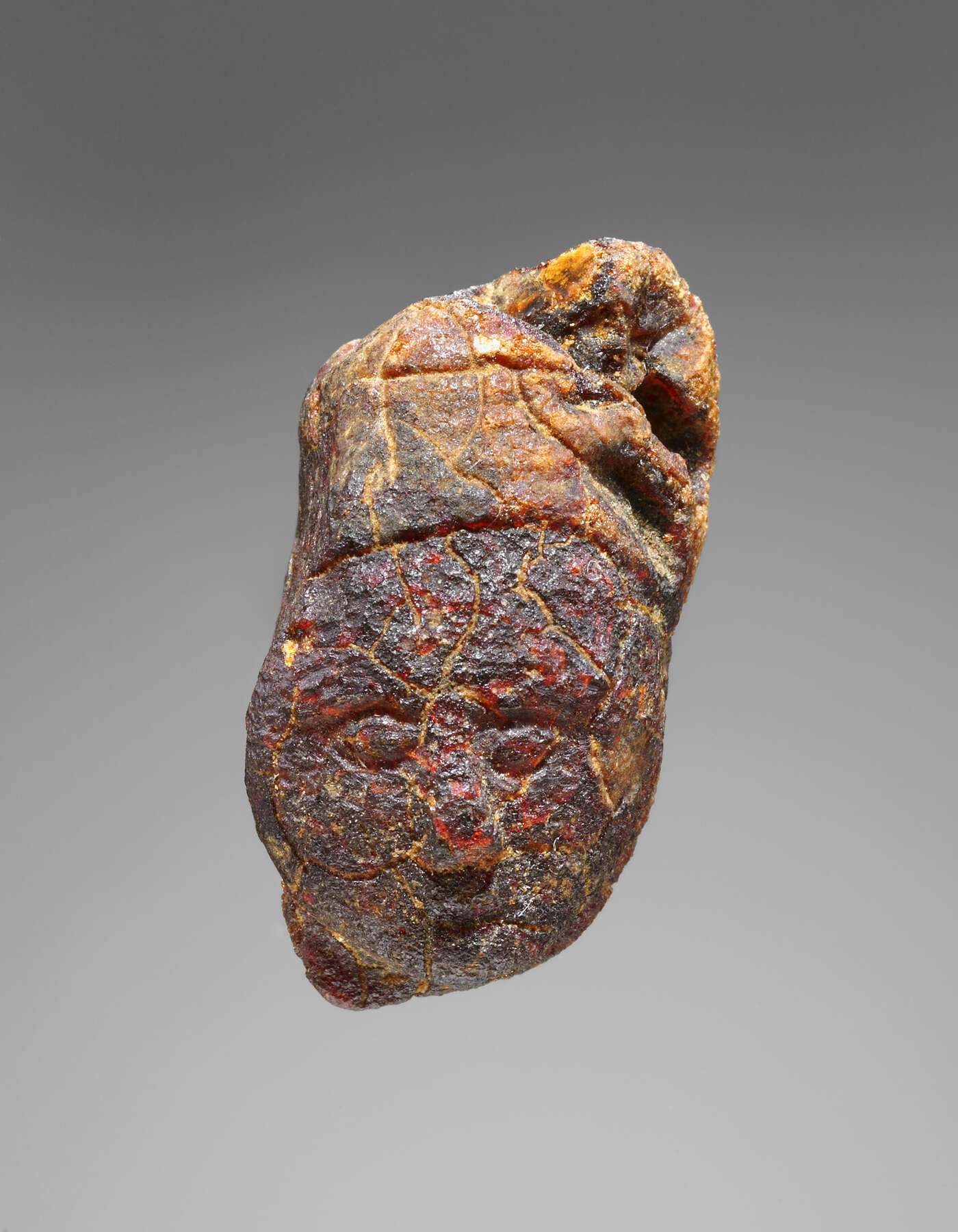16. Pendant: Winged Female Head
| Accession Number | 77.AO.81.29 |
| Culture | Etruscan |
| Date | 525–480 B.C. |
| Dimensions | Height: 40 mm; width: 20 mm; depth: 18 mm; Diameter of suspension hole: 6 mm; Weight: 8.7 g |
| Subjects | Etruscan culture |
Provenance
–1977, Gordon McLendon (Dallas, TX), donated to the J. Paul Getty Museum, 1977.
Condition
The piece is largely intact, except for a large loss at the top proper right of the pendant. The lateral suspension perforation passes through two fissures and is broken off at the top of the left exit. There is wide-interval cracking and crazing over the entire surface. Degraded amber residue, yellow-ocher in color, covers parts of the surface and is inside the cracks. In ambient light, the piece is opaque and dark reddish brown; in transmitted light, it is translucent and red. There are no visible inclusions.
Description
This head-pendant of a female figure includes the head and neck, which are contorted and abbreviated to fit the natural shape of the amber blank. The pendant is rounded on the obverse and nearly flat on the reverse, which is undecorated. The composition is asymmetrical: the figure is more deformed on her right side and more naturalistic on her left. The woman’s face is round but relatively lean. The high forehead is flat and smooth, and her brow ridge is modeled. She has full, wide cheekbones, shallow cheeks, and a small, pointed chin. The eyes are small and deep-set, with the orbits plastically rendered. The eyelids are indicated by engraved lines. The outer corners of the eyes turn up slightly. The nose is indented at the bridge, and its tip is missing. The lips curve up slightly; below them is an indentation representing the mentolabial sulcus. The area below the chin is flat. The junction of the neck is higher than the point of the chin.
The headdress, a conical hat with veil, or perhaps a cloth-wrapped hat, sits directly on the forehead and is separated from the smooth brow by an engraved line. No hair shows on the forehead. Four horizontal grooves and a finer horizontal engraved line suggest the layers or wrapping of the headdress. On the upper left side of the figure’s head is a volute-shaped wing. At the side of the neck is a long, narrow segment of undifferentiated amber, which is set off from the neck by a long groove. It probably represents a long, single hank of hair.
The suspension perforation is drilled in the upper part of the headdress and is 6 mm in diameter at its widest point.
Discussion
Both the iconography and the style of this amber are Etruscan. The rounded, almost egg-shaped head is that of Emeline Richardson’s Middle Archaic korai, which she dates to the third quarter of the sixth century B.C. What Richardson has proposed about this series of bronzes might also describe 77.AO.81.29: “The longest axis [is] from crown to chin, at an angle to the vertical.”1 The best parallels for 77.AO.81.29 among this Richardson grouping are bronzes in Florence from the votive deposit of Fonte Veneziana, Arezzo, including Museo Archeologico Nazionale 258 and 265–67.2
77.AO.81.29 belongs to a family of amber head-pendants that are characterized by their sharp features—wide cheekbones, thin cheeks, pointed chins—vestigial necks, single locks of hair hanging down, and high headdresses. 77.AO.81.29 is a relative of the oldest-looking head from Tomb 106 at Banzi. The latter is one of a group of thirteen pendants, of different types and styles, from a grave dated to the second half of the fifth century B.C.3
Notes
- , pp. 258–59. ↩
- Ibid., pp. 259–62, figs. 583–84 (Florence 258), figs. 590–91 (Florence 265), figs. 588–89 (Florence 266), and figs. 590–91 (Florence 267). Florence 266 is the earliest bronze to wear the diagonal Ionian mantle. ↩
- Melfi, Museo Archeologico Nazionale del Melfese “Dinu Adamesteanu” 116846: , pp. 59–61, no. 8, fig. 2.8. The Getty amber may also be compared to two head-pendants from two different tombs at Banzi, one from the early-fifth-century Tomb 106 (illustrated in , p. 50) and the other from the end-of-the-fifth-century Tomb 428 (ibid., p. 125). ↩
Bibliography
- Bottini 1990
- Bottini, A. “Le ambre intagliate a figura umana del Museo Archeologico Nazionale di Melfi.” Archeologia: Wrocław Zakład Narodowy im. Ossoli’nskich 41 (1990): 57–66.
- Magie d’ambra 2005
- Magie d’ambra: Amuleti e gioielli della Basilicata antica. Exh. cat. Potenza, 2005.
- Richardson 1983
- Richardson, E. H. Etruscan Votive Bronzes: Geometric, Orientalizing, Archaic. 2 vols. Mainz am Rhein, 1983.
